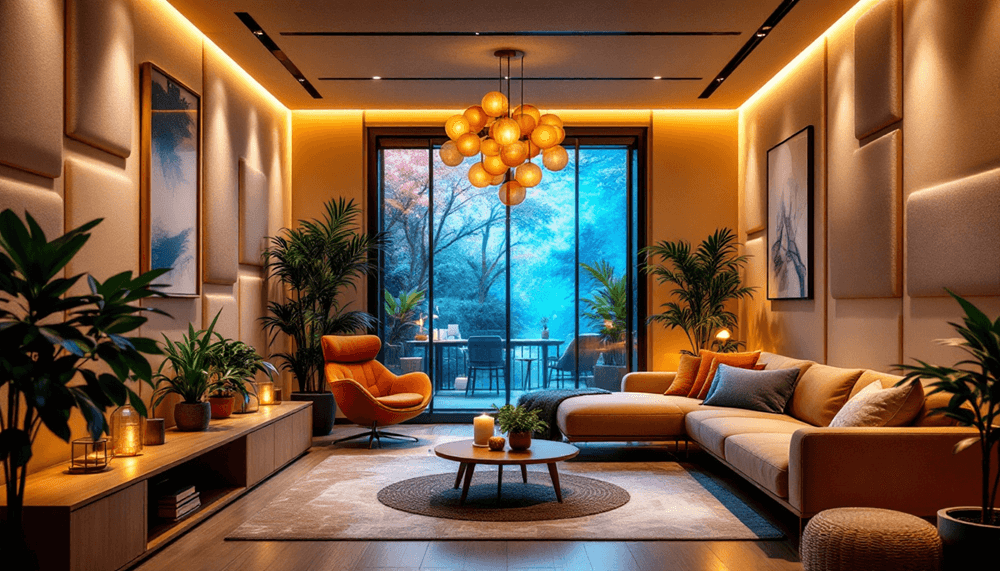Physiological Effect of Color in Interior Design.
Design is a visual language that appears in every corner of our lives. The objects, spaces, and digital interfaces around us leave deep impressions on our subconscious. However, the influence of design is not limited to just an aesthetic experience. Scientific research shows that design profoundly affects our physiological and psychological dimensions. Colors, shapes, textures, and layouts can alter our body’s hormones, heart rate, and even brain activities. Interiors not only offer a visual feast but also provide a physiological and psychological experience that directly affects our quality of life. Our homes, offices, and even waiting rooms are filled with elements that determine how our body and mind respond. Among these elements are colors, light, materials, and arrangements.
The Hidden Power of Colors on Our Body
- Red: Increases energy and boosts performance, but excessive use can accelerate heart rate, leading to stress and tension. Ideal for energetic environments such as gyms and restaurants.
- Blue: Slows the heart rate to provide relaxation, encourages sleep, and reduces blood pressure to lower stress. Ideal for bedrooms and spa centers.
- Green: Reduces eye strain, lowers blood pressure, decreases stress, and relaxes the nervous system. By strengthening our bond with nature, it creates a psychologically healing effect. Suitable for workspaces and relaxation corners.+
- Yellow: Increases the level of serotonin, the happiness hormone, providing energy and supporting creativity. However, excessive use can cause distraction and even irritability. Suitable for children’s rooms and kitchens.
- Purple: Encourages creativity, nurtures imagination, and provides relaxation. However, excessive use may lead to melancholy. Ideal for art studios and meditation rooms.+
The Enchanting Effect of Light
Natural Light: Regulates the secretion of the hormone melatonin, thereby affecting sleep patterns, improving mood, strengthening the immune system, and contributing to the production of vitamin D.
Artificial Light:
Warm White Light: Creates a warm and inviting atmosphere, provides relaxation, and enhances social interaction.
Cool White Light: Enhances focus and productivity, but prolonged exposure may cause eye strain.
Infrared Light: Relaxes muscles, reduces pain, and supports skin regeneration.
Blue Light: Provides energy and increases alertness, but may disrupt sleep patterns.
The Physiological Impact of Spatial Arrangement
- Feng Shui: Aims to enhance health, happiness, and prosperity by regulating the flow of energy. The arrangement of space, placement of furniture, and the use of natural light are fundamental principles of this philosophy.
- Biophilic Design: A design approach that aims to enhance human health and well-being by establishing a connection with nature. The use of plants, natural materials, and natural light are the fundamental elements of this approach.
Scientific Foundations and Support of the Factors Influencing Interior Design in Terms of Their Physiological Effects
- Neuroaesthetics: Using brain imaging techniques, the ways in which colors, lights, and spaces affect brain activities are examined.
- Physiology: Studies on how colors affect heart rate, respiration, and blood pressure have demonstrated the importance of using color in interior design.
- Psychology: Research on how colors shape our emotional state and behaviors emphasizes the importance of psychology in interior design.
- Ergonomics: Aims to increase comfort and efficiency by considering the physiological characteristics of the human body. Proper seating posture, adequate movement space, and appropriate lighting are fundamental principles of ergonomics.
- Lighting Design: In interior design, lighting is not only a visual element but also one that significantly impacts a person’s physiological and psychological health. It enables designers to create healthier and happier living spaces. Natural and artificial lighting have different physiological effects on an individual.
- Sound Design: Sound affects a person’s emotional state and concentration. Sound insulation reduces noise, lowers stress levels, and increases attention. The arrangement and control of acoustics and echoes provide motivation in various spatial perceptions. Natural sounds (such as birdsong or water sounds) or music help with relaxation.
- Scent Design: Scent is often overlooked, but it is an extremely effective element in interior design. Scientific research shows that scent has profound effects on our physical health. The proper use of scents in interiors plays an important role in bodily health. Scent reduces stress, improves sleep quality, strengthens the immune system, and plays a major role in enhancing concentration.
Conclusion
Interior design is not merely an aesthetic concern but also a significant factor for human health and happiness. The thoughtful use of colors, light, materials, and arrangements enables us to create healthier, happier, and more productive living spaces. The right choices in color, lighting, and materials positively affect our body and mind, thereby enhancing our quality of life. Therefore, when designing interiors, it is important to consider not only aesthetic aspects but also the physiological effects supported by scientific data.







